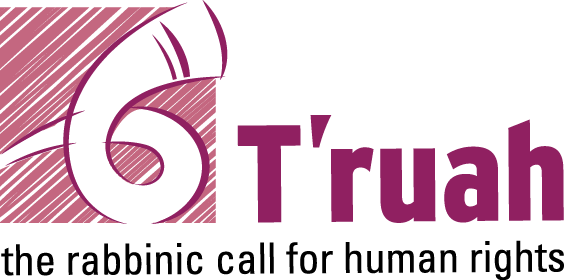Yom Kippur, the Talmud declares, is one of the most joyous days of the year because it is “a day of pardon and forgiveness, and the day on which the second tablets were given.” (Bava Batra 121) It’s a day of new beginnings, in which we shed the mistakes of the past year, and on which God granted the Israelites a second chance, in the form of a new set of tablets to replace those shattered in response to the sin of the golden calf.
It’s hard to talk about joy right now, in the midst of so much suffering in Gaza, Israel, the U.S., and beyond. But perhaps we can allow ourselves to imagine the possibility of new beginnings.
Here’s some of what gave me hope this past week: On Friday and Monday, T’ruah and several partner organizations organized silent protests while Prime Minister Netanyahu spoke at the UN, and as he prepared for his meeting at the White House.
Dozens of American Jews and Israelis stood holding signs with photos of children killed in Gaza and the hostages Netanyahu has abandoned.
Many passersby stopped to stare, confused by the juxtaposition. Was this a pro-Israel or pro-Palestine protest? Our presence helped to break down the false dichotomy that one must choose between caring about Israelis and caring about Palestinians.


On Sunday, we co-hosted a conversation with Aziz Abu-Sarah and Maoz Inon, two peace activists — one Palestinian and one Jewish Israeli, one whose brother died as a result of imprisonment in Israel, and one whose parents were killed on October 7, who have chosen to reject calls for revenge and to work toward peace. They pushed us to move beyond despair, to think bigger, and to imagine that a better future is possible.
All week long, I’ve been reading sermons that our chaverim, rabbi and cantor members, are sharing with each other for inspiration and support. These sermons demonstrate courageous moral leadership. Rabbis across the country are taking risks and challenging their communities to be more active in opposing the war, and in listening both to Palestinian and Israeli voices.
And yesterday, President Trump announced that Israel has accepted a plan to end the war, and called on Hamas to do the same.
This proposal is a mixed bag. We know that neither Trump nor Netanyahu has the best interests of Israelis and Palestinians at heart. And we know that you can’t make a deal between two parties when one of those parties isn’t at the table.
But we are also desperate for the U.S. to use its power to pressure Netanyahu to end the war and stop the killing. Could this be the first step toward that end?
Certainly, there are reasons to reject this plan. It puts Donald Trump at the head of a “Board of Peace” that will oversee the transitional government. It does not lay out a clear timeline for Israel to leave Gaza. It pays lip service to a Palestinian state, but provides no clear roadmap. It does not mention the West Bank or settler violence.
It is filled with what Obama-era diplomat Frank Lowenstein called “poison pills” — conditions that Hamas is extremely unlikely to accept and which therefore will give Netanyahu tacit permission to abandon the deal and continue the destruction and occupation of Gaza.
But there are also elements that mirror parts of both the Biden administration’s ceasefire proposal and the French and Saudi-led New York Declaration presented last week.
The plan calls for the immediate release of the hostages, the demilitarization of Hamas, a transitional international peacekeeping body, increased aid, and for the IDF to withdraw from Gaza and not to occupy or annex it. There is, thank God, no mention of Trump’s previous plan for a “Gaza Riviera,” and there is an explicit promise that no Palestinians will be forced to leave Gaza.
If this marks a turning point, we will celebrate that. But our work is far from over. We will keep holding these leaders accountable to the human rights of Palestinians in Gaza and the West Bank, to the Palestinians’ right to self-determination in a state of their own, and to international law. We will keep working for an end to the occupation and for a political solution that protects the self-determination of both peoples and the human rights of all.
In our biblical story of second chances, the second tablets that the Israelites receive are not identical to the first. They are written in Moses’ hand, not God’s, and therefore represent a divine-human partnership. Unlike the first tablets, the midrash says, the second are given in private, not in public. “In this instance, the Holy Blessed One said there is nothing more desirable than humility.” (Tanchuma Ki Tissa 31)
In a world of hot takes and of insistence on ideological purity, it takes humility to say that we don’t know what is going to happen — that we don’t know whether the Trump plan will bring an end to the suffering, or usher in an even more dangerous time. But if there is a chance to end the war, stop the killing of Palestinians, and bring the hostages home, we hope that all parties will invest in making it work.
After granting the people this second set of tablets, the midrash notes, God commands them to build a sanctuary. God seems to understand that the people need a positive communal project — not just something to tear down but something to build up. Through building the Mikdash, they learn to take a more active role in their own fate.
It’s easy to despair, and to give up. The challenge is to believe that a different world is possible, to draw the blueprints, and to build it little by little. The joy of Yom Kippur stems from the promise that each of us individually, and all of us collectively, have this chance for a new beginning.
G’mar chatimah tovah,

Rabbi Jill Jacobs
she/her/hers
CEO, T’ruah
